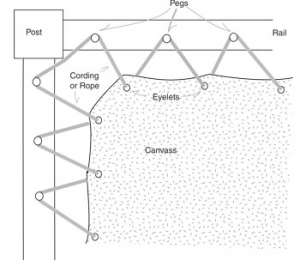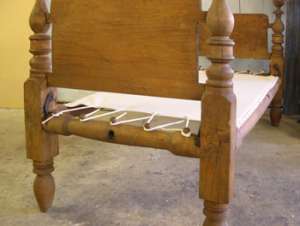Roping A Bed
The Country Bed Shop sells original antique beds and makes reproductions of antique beds as well as other furniture we are occasionally asked to provide information on how to rope an early bed. Note that beds with pegs in the top of the rail were not meant to be roped. They used a “sacking bottom” which is made of sail cloth (canvas) with eyelets along the edge and linen cording running between the eyelet and the peg. Rope beds always have holes through the rail.
 You will need an adequate length of rope. Early beds used hemp or linen rope. You can use manila rope as a substitute for hemp. The diameter of the rope should be slightly smaller than the diameter of the hole in the rail. You will also need a straining wrench (Spanish windlass, bed key), a couple awls or large nails (golf tees also work). Refer to the diagram below as you proceed. Note the Roman numerals at the corners are the markings I use for the reproduction beds I make. Early beds may have different numbering.
You will need an adequate length of rope. Early beds used hemp or linen rope. You can use manila rope as a substitute for hemp. The diameter of the rope should be slightly smaller than the diameter of the hole in the rail. You will also need a straining wrench (Spanish windlass, bed key), a couple awls or large nails (golf tees also work). Refer to the diagram below as you proceed. Note the Roman numerals at the corners are the markings I use for the reproduction beds I make. Early beds may have different numbering.
Tie a simple loop knot in one end of the rope and use some tape to lash the other end so it does not fray as you string it through the holes. Starting at the left most hole at the head of the bed string the rope back an forth the length of the bed. when you go through the right most hole at the head end carry the rope under the rail and inside the post to the first hole in the side rail. Weave the rope over and under the rope going lengthwise. Repeat until you reach the last hole in the side rail.
To tighten the rope start at point “A”. Put the straining wrench (see below) through the rope like a clothes pin and use the handle to twist the wrench. While holding the rope taut with the wrench, jam your awl into the hole to hold the tension while you go to the head of the bed and tighten the next length of rope “B” in the same manner. Repeat this in the same order in which you wove the rope until you reach the end “D”. At this point, wrap the rope around the wrench to secure it and tighten as before except this time jam the awl from the inside of the rail. Tie a secure slip knot as close to the outside of the rail as possible. Trim off any excess rope. Here is an example of one of my reproduction beds with a rope spring.
Rope springs do stretch with time so yours may need periodic tightening. 
Straining Wrench, 12″ tall
Purchase
Hemp rope is made from a strain of the marijuana plant grown for it fibrous stem. It is illegal to grow hemp in the U.S. Although hemp rope is imported, asking for it at your local hardware store will get you a knowing smile and possibly a visit from your local law enforcement agency.
Manila rope began to substitute for hemp rope about 1820. It is made from fibers of the abaca plant, a relative of the banana. Manila rope is either natural or oiled. Oiled rope is for outdoor use and should not be used on beds as it will stain the bedding. The rope is not necessarily labeled. Oiled rope feels and smells oily and may be labeled “Not for Use with Animals”. Natural rope feels dry and smells, if at all, like dry hay.

Sacking Bottom, one corner of bed shown.
Beds with pegs in the rails or a simple rebate with evidence of tacks were design for a sacking bottom. The sacking bottom was a rectangle of sail cloth with eyelets to correspond to the pegs in the rail. It provided a smooth surface for the bed tick or mattress. We have an uphosterer make up sacking bottoms on request. Each is made to fit the individual bed. See the bed below which is corded on the end rails and tacked on the side. See Living History below for evidence that these beds were sometimes roped rather than “sheeted”.
For more information please email us. For the measurements required see the spec sheet. Here is an informative brochure on early bedding from Textile Reproductions. 
Below is an excerpt from a contemporary on health and beds
“The Young Mother. Management of Children in Regard to Health”, William A. Alcott, George W. Light publisher, 1836
Sec. 4. The Bed.
Mattresses are better for persons of every age, than soft feather beds. They may be made of horse hair or moss; but hair is the best. If the mattress does not appear to be warm enough for the very young infant, a blanket may be spread over it. Dr. Dewees says that in case mattresses cannot be had, “the sacking bottom” may be substituted, or “even the floor;” at least in warm weather: “for almost anything,” he adds, “is preferable to feathers.”
Living History from an email recieved in 2011
Your website is quite interesting. I am 83 and have been sleeping on rope beds almost all of my life. As a youth, my bed was a peg bed that was roped (not sheeted) and had a hard cot type mattress. I graduated to a rope hole bed with an innerspring mattress.
My current bed was originally an old yellow pine short pencil post single width rope hole bed that I bought for the first of my sons over 50 years ago. It was also short in length, as was typical of the period. So I scavenged an old yellow pine 4×8 floor joist, carefully checked for broken-off nails, ripped it to 4x4s, planed it to match the width of the posts, routed the side groove, drilled and beveled the holes and lengthened the rails to 72″. I had sufficient wood remaining to widen it to full width (with wider head and foot boards from scavenged yellow pine)
My wife and I have slept on it for 40 years with a thick bed board and a custom innerspring mattress that covers the side rails with cutouts for the corner posts – the only original.portion.
As to rope, I have tried hemp, manila, nylon and cotton. Nylon is impossible because it never stops stretching. I found cotton to be the best and cheapest. But only after an old Chesapeake Bay waterman told me his trick about how to take the “stretch”and “shrink” out of any rope. He would let it out behind a boat and it would not only “unwind” but when it dried it would have “shrunk”. I have never had a cotton rope get any slack since. A friend who didn’t have access to a boat on open water told me he accomplished the same result by hanging cotton rope from a high rise building in the rain with a weight on the end.
Finally, in my family we start roping side-to-side at the foot of the bed so that the change from side-to-side to end-to-end occurs at the head, where it is less conspicuous. And we don’t loop the rope under the rails at the corner change; but instead wrap the rope around a dowel in the groove on the side, put it back through the hole and do the same in the groove on the head rail. Friction holds it in place.
A lot of nostalgia from my past went through my mind as I wrote this. Few people today have any clue when they see holes and sawed off pegs in the rails of old beds, The term “rope bed” means nothing to but a few of us.
I look forward to hearing from you.
George W.
Richmond, VA

